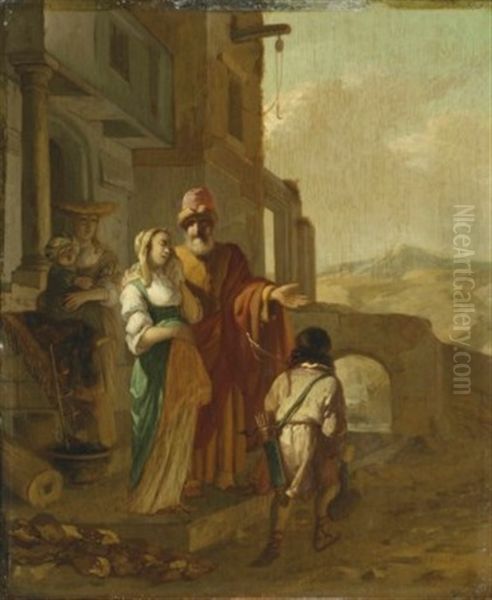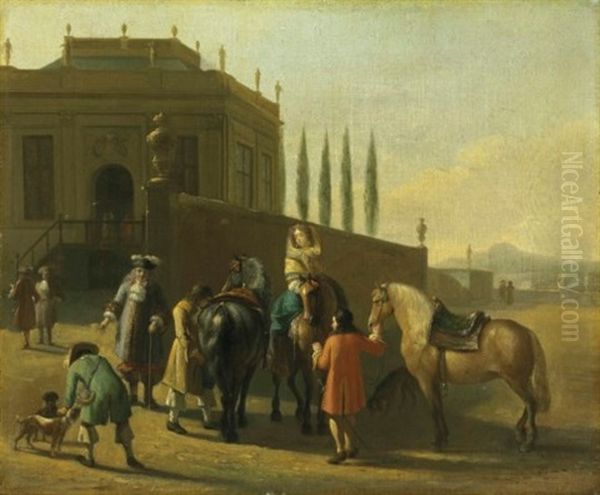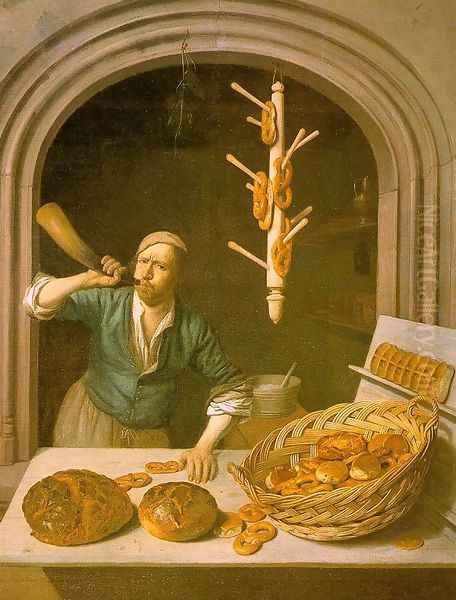Job Adriaensz Berckheyde, a distinguished painter of the Dutch Golden Age, left an indelible mark on the art world through his nuanced depictions of urban landscapes, bustling marketplaces, serene church interiors, and intimate genre scenes. Born in Haarlem on January 27, 1630, and passing away in his native city on November 23, 1693, Berckheyde's life and career unfolded during a period of unprecedented artistic flourishing in the Netherlands. His work not only captures the visual essence of his time but also offers insights into the social, economic, and religious fabric of 17th-century Dutch society.
Early Life and Artistic Formation in Haarlem
Job Berckheyde's journey into the world of art was not immediate. He initially embarked on a different path, serving as an apprentice to a bookseller. This early exposure to the world of letters and commerce in Haarlem, a vibrant cultural and economic hub, may have subtly shaped his later interests in depicting the multifaceted life of the city. However, the allure of the visual arts proved stronger, and on November 2, 1644, he formally began his artistic training.
His first significant mentor was Jacob Willemszoon de Wet, a Haarlem-based history painter known for his biblical scenes and landscapes. Under de Wet's tutelage, Job would have learned the fundamentals of composition, color, and narrative painting. De Wet, himself influenced by an earlier generation of artists and possibly by the circle around Rembrandt van Rijn in his early Leiden period, would have imparted a tradition that valued both historical subjects and an emerging Dutch realism.

Beyond de Wet, the artistic environment of Haarlem itself was a powerful teacher. The city was home to Frans Hals, one of the most innovative portraitists of the era. While direct apprenticeship under Hals is debated by some scholars, his influence, particularly his lively brushwork and ability to capture the character of his sitters, permeated the artistic atmosphere of Haarlem. It is highly probable that Berckheyde absorbed aspects of Hals's dynamic approach, which could have informed his depiction of figures in his genre and urban scenes. The legacy of other Haarlem masters, such as the landscape painters Esaias van de Velde and Jan van Goyen, who had earlier established the city as a center for realistic landscape art, also contributed to the rich artistic milieu in which Berckheyde developed.
Travels in Germany and Early Patronage
In the early 1650s, Job Berckheyde, accompanied by his younger brother Gerrit Adriaensz Berckheyde (who would also become a renowned painter, particularly of cityscapes), embarked on an extended journey through Germany. Such travels were common for ambitious artists seeking to broaden their horizons, study different artistic traditions, and find patronage. Their itinerary took them along the Rhine, visiting prominent cities such as Cologne, Bonn, and Mannheim.
Their travels culminated in a significant stay in Heidelberg, at the court of Charles I Louis, Elector Palatine. The Elector was a known patron of the arts and sciences, and the Berckheyde brothers found favor with him. Their artistic skills were recognized, and they received commissions and accolades, including, according to some accounts, a gold medal or chain from the Elector as a mark of his esteem. This period would have been formative, exposing Job to different architectural styles, landscapes, and possibly courtly life, elements that might have subtly influenced his later work.
Despite the honor and potential for a comfortable court position, the brothers reportedly found the constraints of court life less appealing than the artistic freedom and familiar environment of their homeland. After a period of service, they decided to return to the Netherlands. This experience abroad, however, would have undoubtedly enriched Job's artistic vocabulary and enhanced his reputation upon his return.
Return to Haarlem and Guild Membership
By 1654, Job Berckheyde was back in Haarlem, where he formally established himself as an independent master. A crucial step in this process was his admission into the Haarlem Guild of St. Luke on July 10, 1654. Membership in the guild was essential for any artist wishing to practice professionally, take on apprentices, or sell their work openly in the city. It signified a recognized level of skill and adherence to the standards of the artistic community.

Haarlem's Guild of St. Luke was one of the oldest and most respected in the Netherlands, boasting members like Frans Hals, Adriaen Brouwer (though briefly), Adriaen van Ostade, and later, Jacob van Ruisdael. Within this esteemed company, Job Berckheyde began to carve out his niche. He shared a house and possibly a studio with his brother Gerrit for a considerable time, and their careers, while distinct in their primary focus, often ran parallel.
Later in his life, in 1666, Job also became a member of the rhetoric society "De Wijngaardranken" (The Vine Tendrils), indicating his engagement with the broader cultural and intellectual life of Haarlem. These societies were important social and literary circles. His involvement continued, as records show him serving as a juror for the society in 1682, even when his health may have been declining.
Artistic Style: Light, Detail, and Naturalism
Job Berckheyde's artistic style is characterized by a meticulous attention to detail, a sophisticated understanding of light and shadow, and a commitment to naturalistic representation. While his brother Gerrit became famous for his almost photographically precise cityscapes, Job's work, though often equally detailed, frequently incorporated a stronger narrative element and a warmer, more atmospheric use of light.
His handling of light is particularly noteworthy. Whether illuminating the intricate stonework of a church interior, casting shadows across a bustling market square, or highlighting the figures in a domestic scene, Berckheyde demonstrated a keen ability to use light to create depth, mood, and focus. This sensitivity to chiaroscuro aligns him with a broader trend in Dutch Golden Age painting, seen in the works of masters like Johannes Vermeer and Pieter de Hooch, who explored the subtleties of light in interior spaces.
Berckheyde's brushwork is generally fine and controlled, allowing for the precise rendering of textures – the roughness of stone, the sheen of fabric, the clutter of a workshop. This detailed approach was highly valued by Dutch patrons, who appreciated the verisimilitude and craftsmanship evident in such paintings. While he could be precise, his figures often possess a certain liveliness and character, perhaps a distant echo of Frans Hals's influence or a shared Haarlem sensibility.
His compositions are typically well-balanced and thoughtfully constructed, guiding the viewer's eye through the scene. In his architectural pieces, he often employed strong perspectival lines to create a convincing sense of space, a skill honed by Dutch artists like Pieter Saenredam, the great pioneer of church interior painting, and later Emanuel de Witte.
Key Themes and Subjects in Berckheyde's Oeuvre

Job Berckheyde's thematic range was broader than that of his brother Gerrit. While Gerrit specialized almost exclusively in cityscapes and prominent buildings, Job explored a variety of subjects, showcasing his versatility.
Urban Landscapes and Architectural Views
Like his brother, Job painted views of cities, though perhaps with less frequency. His depiction of The Old Exchange Amsterdam (circa 1670, Museum Boijmans Van Beuningen, Rotterdam) is a prime example. This painting captures the vibrant commercial heart of Amsterdam, filled with merchants and citizens engaged in trade. Berckheyde meticulously renders the architecture of Hendrick de Keyser's famous building and populates its courtyard with numerous figures, creating a lively tableau of 17th-century economic activity. Such works appealed to civic pride and the burgeoning merchant class's interest in representations of their prosperous society. He also reportedly contributed to the design of the courtyard layout for this very exchange, showcasing a practical architectural understanding.
Church Interiors
The depiction of church interiors was a distinct and popular genre in the Dutch Golden Age, reflecting both religious sentiment and an appreciation for architectural beauty. Following the Reformation, Dutch churches were often stripped of elaborate Catholic ornamentation, leading to an emphasis on their stark, light-filled spaces. Job Berckheyde excelled in this genre. His Interior of the Grote Kerk, Haarlem (also known as St. Bavokerk), with versions painted in 1668 and between 1675-1680 (both associated with the Frans Hals Museum, The Hague), are masterpieces of architectural painting. He masterfully captures the soaring Gothic arches, the play of light through the tall windows, and the sense of serene grandeur within these sacred spaces. His approach can be compared to that of Pieter Saenredam, known for his luminous and precise church portraits, and Emanuel de Witte, who often introduced more anecdotal human elements into his church scenes.
Genre Scenes: Daily Life and Professions
Job Berckheyde produced a significant number of genre scenes, depicting everyday life and various professions. These works offer fascinating glimpses into the social fabric of the time. The Baker (circa 1681, Worcester Art Museum) is a wonderful example, showing a baker in his shop, surrounded by loaves of bread, baskets, and the tools of his trade. The painting is notable for its warm lighting and detailed rendering of the scene's elements.
Another important genre piece is Office of a Notary Public (1672, Amsterdam Museum). Notaries played a crucial role in 17th-century Dutch society, documenting legal and commercial transactions. Berckheyde’s depiction captures the serious atmosphere of such an office, with figures engrossed in their work amidst ledgers and documents. Musicians at Breakfast (1670s, Amsterdam Museum) and The Courtyard of Bourcy (1670-1680, Amsterdam Museum) further illustrate his interest in varied aspects of contemporary life, from leisurely pursuits to domestic settings. These works align him with other great genre painters like Pieter de Hooch, Gabriel Metsu, and Jan Steen, each of whom brought their unique perspective to the depiction of Dutch daily existence.
Biblical and Historical Scenes
Reflecting his training with Jacob Willemszoon de Wet, Job Berckheyde also painted biblical and, to a lesser extent, historical subjects. While perhaps not as numerous as his other works, these paintings demonstrate his ability to handle narrative compositions and convey dramatic or poignant moments. Hagar and Ishmael Banished (1681, Amsterdam Museum) is an example of his work in this vein, treating a traditional Old Testament theme with the characteristic Dutch attention to human emotion and setting. This continued engagement with history painting, even as other genres gained prominence, shows his connection to a more established artistic tradition, similar to artists in Rembrandt's circle like Gerbrand van den Eeckhout or Ferdinand Bol who also balanced biblical subjects with portraiture or genre.
Other Subjects
Berckheyde's oeuvre also includes less common subjects for him, such as A Hunting Party (Amsterdam Museum), indicating a willingness to explore different pictorial challenges. His painting Studio Visit (location varies, but a theme he explored) provides a fascinating look into the artist's world, a subject also tackled by contemporaries like Adriaen van Ostade and, most famously, Johannes Vermeer in his Art of Painting.
Representative Works: A Closer Look
Several of Job Berckheyde's paintings stand out as particularly representative of his skill and thematic concerns.
_The Old Exchange Amsterdam_ (c. 1670): This work is a vibrant depiction of Amsterdam's commercial hub. Berckheyde skillfully manages a complex composition with numerous figures, each individualized yet contributing to the overall sense of bustling activity. The architecture is rendered with precision, and the play of light across the courtyard adds depth and realism. It stands as a testament to Dutch economic power and civic pride, comparable in spirit to cityscapes by Jan van der Heyden, though Berckheyde often included more prominent figural groups.
_Interior of the Grote Kerk, Haarlem_ (1668): This painting showcases Berckheyde's mastery of architectural perspective and his ability to capture the ethereal quality of light within a large sacred space. The towering columns, the intricate vaulting, and the subtle gradations of light filtering through the windows create a profound sense of peace and awe. The small figures scattered within emphasize the vastness of the edifice. His work in this area invites comparison with the serene, almost abstract purity of Saenredam's church interiors and the more populated, atmospheric views of Emanuel de Witte.
_The Baker_ (c. 1681): A charming and insightful genre scene, The Baker exemplifies Berckheyde's interest in the lives of ordinary working people. The composition is intimate, focusing on the baker and his wares. The warm, earthy tones and the careful depiction of textures – the crust of the bread, the weave of the baskets – make the scene tangible. It reflects a broader Dutch interest in celebrating diligence and everyday occupations, a theme also explored by artists like Quiringh van Brekelenkam.
_Office of a Notary Public_ (1672): This painting is significant for its depiction of a key professional activity in 17th-century Dutch society. Berckheyde captures the serious, focused atmosphere of the notary's office. The figures are absorbed in their tasks, surrounded by the paraphernalia of their profession – documents, quills, and ledgers. The careful arrangement of figures and objects, and the controlled lighting, contribute to the painting's air of quiet diligence.
The Berckheyde Brothers: A Shared Life, Distinct Paths
The relationship between Job and his younger brother Gerrit Adriaensz Berckheyde is an interesting aspect of their careers. They shared a close bond, traveling together in their youth and living together for many years in Haarlem. They were both members of the Guild of St. Luke and likely shared studio space, at least for a time.
Despite these close ties, their artistic specializations diverged. Gerrit became almost exclusively known for his highly detailed and accurate cityscapes, particularly views of Haarlem, Amsterdam, and The Hague. His works are characterized by their bright, even lighting and meticulous rendering of architectural detail, often with a slightly cooler palette than Job's. Gerrit's paintings, such as his numerous views of the Amsterdam Town Hall or the Grote Markt in Haarlem, are iconic representations of Dutch urban environments.
Job, while also a capable painter of city views and architecture, had a broader thematic range. His interest in genre scenes, biblical narratives, and more varied interior settings distinguished his output from Gerrit's more focused specialization. Job's lighting is often more atmospheric, his figures sometimes more prominent and engaged in narrative action. While both brothers contributed significantly to the Dutch Golden Age, their individual artistic personalities remained distinct.
Artistic Connections and Collaborations
Beyond his brother and his initial teacher, Job Berckheyde's artistic world would have involved interactions with numerous other painters in Haarlem and beyond. The Guild of St. Luke provided a forum for such exchanges.
There is evidence that, like many artists of the period who specialized in landscapes or architectural views, Berckheyde sometimes collaborated with other painters who were specialists in figure painting (staffage). While Berckheyde was certainly capable of painting his own figures, for certain commissions or to enhance particular effects, he may have employed artists like Johannes Lingelbach or Jan van Huchtenburg. Lingelbach, who spent time in Italy, was known for his lively figures in Italianate landscapes and market scenes, while Huchtenburg specialized in battle scenes and horses. Such collaborations were common practice and aimed at producing the highest quality work by combining the strengths of different specialists. For instance, a landscape painter like Meindert Hobbema often had figures added to his scenes by Adriaen van de Velde or Lingelbach.
His style also shows an awareness of trends and innovations by other leading artists. His church interiors, for example, build upon the foundations laid by Saenredam. His genre scenes resonate with the broader interest in daily life explored by Vermeer, de Hooch, Metsu, and Steen, though Berckheyde developed his own distinct approach within these popular themes. The influence of Peter van Ruijven, primarily known as Vermeer's patron but also a painter, has been suggested by some scholars, possibly in terms of thematic choices or compositional strategies in genre painting.
Later Life, Legacy, and Enduring Appeal
Job Adriaensz Berckheyde remained in Haarlem for the remainder of his life, continuing to paint and contribute to the city's artistic community. He never married and, as mentioned, lived with his brother Gerrit for a significant period. He passed away on November 23, 1693, and was buried in his beloved Haarlem.
His legacy is that of a versatile and highly skilled painter who captured the essence of Dutch Golden Age life and architecture. His works are found in major museums around the world, valued for their artistic quality, historical insight, and charming depictions of 17th-century Holland. While perhaps sometimes overshadowed by his brother Gerrit's fame as a cityscape specialist, or by the towering figures of Rembrandt, Vermeer, and Hals, Job Berckheyde holds a secure and respected place in the pantheon of Dutch Golden Age masters.
His paintings of church interiors continue to impress with their spatial coherence and sensitive rendering of light. His urban scenes provide invaluable records of city life and architecture. His genre paintings offer intimate and engaging glimpses into the daily routines, professions, and social interactions of his time. Through his diverse body of work, Job Adriaensz Berckheyde provided a rich and enduring visual chronicle of one of the most dynamic periods in European art history, his canvases reflecting the prosperity, piety, and pragmatism of the Dutch Republic. His meticulous craftsmanship and keen observational skills ensure that his art continues to captivate and inform viewers centuries later.